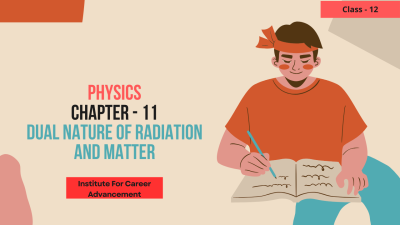Dual Nature Of Radiation And Matter - Class 12
In Class 12, Wave Optics takes you beyond the ray model of light and explores its wave nature. Here's a quick overview: Light as a Wave: This approach treats light as a wave phenomenon, similar to ripples in water. Light waves have properties like wavelength, frequency, and amplitude. Interference and Diffraction: You'll delve into fascinating phenomena like interference, where light waves can cancel each other out or strengthen each other, and diffraction, where light bends around corners. Going Beyond Ray Optics: While ray optics is a useful tool, wave optics provides a more complete picture of light's behavior. It explains phenomena like the observed colors in thin films (like soap bubbles) and the bending of light around objects. দ্বাদশ শ্রেণিতে, ওয়েভ অপটিক্স আপনাকে আলোর রশ্মি মডেলের বাইরে নিয়ে যায় এবং এর তরঙ্গ প্রকৃতি অন্বেষণ করে। এখানে একটি দ্রুত ওভারভিউঃ তরঙ্গ হিসাবে আলোঃ এই পদ্ধতিটি আলোকে তরঙ্গের ঘটনা হিসাবে বিবেচনা করে, জলের তরঙ্গের মতো। আলোক তরঙ্গের তরঙ্গদৈর্ঘ্য, ফ্রিকোয়েন্সি এবং প্রশস্ততার মতো বৈশিষ্ট্য রয়েছে। হস্তক্ষেপ এবং বিচ্ছুরণঃ আপনি হস্তক্ষেপের মতো আকর্ষণীয় ঘটনাগুলির মধ্যে প্রবেশ করবেন, যেখানে আলোর তরঙ্গগুলি একে অপরকে বাতিল করতে পারে বা একে অপরকে শক্তিশালী করতে পারে এবং বিচ্ছুরণ, যেখানে কোণের চারপাশে আলো বাঁকানো থাকে। রে অপটিক্সের বাইরে যাওয়াঃ যদিও রশ্মি আলোকবিজ্ঞান একটি দরকারী হাতিয়ার, তরঙ্গ আলোকবিজ্ঞান আলোর আচরণের আরও সম্পূর্ণ চিত্র সরবরাহ করে। এটি পাতলা পাত্রে (যেমন সাবানের বুদ্বুদ) পর্যবেক্ষণ করা রঙ এবং বস্তুর চারপাশে আলোর বাঁকনের মতো ঘটনাগুলি ব্যাখ্যা করে।
English
Last updated
Wed, 27-Nov-2024



















